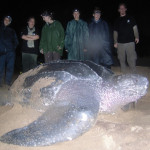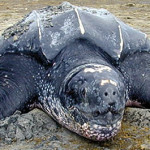![]() There are a few theories about why sea turtles make occasional excursions into very deep (> 1000 m) waters of the bathyal zone. These involve escape from predation, thermoregulation, and prey availability. In the first two scenarios, sharks are fewer in deep-water, so turtles can evade predation and “cool off” at the same time. Like ladies tanning on the balcony. In the third scenario, sea turtles are foraging. New research suggests this theory is half-right.
There are a few theories about why sea turtles make occasional excursions into very deep (> 1000 m) waters of the bathyal zone. These involve escape from predation, thermoregulation, and prey availability. In the first two scenarios, sharks are fewer in deep-water, so turtles can evade predation and “cool off” at the same time. Like ladies tanning on the balcony. In the third scenario, sea turtles are foraging. New research suggests this theory is half-right.
We touched on this a year ago during Megavertebrate Week noting the abundance of deep sponges in certain habitats in the comment section of a story by then Duke University sea turtle researcher Bryan Wallace. Leatherbacks are well equipped for deep diving. But why? What’s down there?
During Coral Week, the story things that eat coral pointed viewers to a National Geographic critter-cam video showing a green turtle eating a sea-pen. Sea-pens are an abundant benthic resource in the deep-sea closely related to the medusoid prey turtles forage upon in shallow waters. Different turtles have different preferences, but most will eat just about anything, really, including crabs, sponges, and plastic.
Helping to settle the question of why leatherbacks dive so deep, Jonathon Houghton and colleagues at University of Swansea in Britain (abstract here) analyzed 26,000 dives by satellite-tracked leatherback turtles in the North Atlantic Ocean. They propose that leatherback turtles are most likely scouting for jellies that migrate to the depths during the day, and then arise later that night. A reconnaissance dive, they would argue, is a more efficient dive strategy than an actual foraging dive at similar depths.
But who’s to say they don’t snack? To leatherback turtles, extremely deep diving is like ducking into a restaurant to check the atmosphere, and the menu.
Researchers found deep dives happen rarely. Less than 1% of the dives (95 total) were deeper than 300m. The water didn’t get any cooler past this point, casting doubt on the thermoregulation hypothesis. The predator evasion hypothesis is weak, in my opinion. If this were true, sea turtles would constantly live in fear, like chihuahuas. It seems contrary to their mellow sea turtle nature.
DSN sea turtle and field correspondent Wallace J Nichols of Ocean Conservancy has this to say about the great deep diving debate:
Our team has tracked dozens of hard-shelled turtles with transmitters and dive recorders and we have been amazed by their long, deep dives and enormous migrations. But it’s the leatherback turtles that set all the records. This study pushes us further into the realm of the mysterious deep ocean. The next generation of transmitters will include imaging abilities, which will solve all kinds of mysteries…and expose new ones.
Reference:
Houghton, J.D., Doyle, T.K., Davenport, J., Wilson, R.P., Hays, G.C. (2008). The role of infrequent and extraordinary deep dives in leatherback turtles (Dermochelys coriacea). Journal of Experimental Biology, 211(16), 2566-2575. DOI: 10.1242/jeb.020065






as an undergrad, my marine zoology professor (who was a marine reptile specialist) told us stories about how, when the outer mississippi river outflow was being dredged for deeper draft ships, the dredge grabber would frequently dump big leatherbacks onto the tailings pile…
apparently these old turtles were hibernating (in torpor?) on the bottom… when asked how they could do this as air breathers, our professor informed us that sea turtles can “breathe” (carry on aerobic respiration) by drawing water into their highly vascularized rectum, engage in oxygenated exchange, and repeat as needed…
given that deep cold water is more oxygenated, i wonder if they are diving for rest stops and a little butt breathing?
Because it can.
.. butt-breathe?
sorry, i meant cloacal bursae breathing
What, no random “Jonathan Livingston Seagull” reference? We’re not the only animals who sometimes do things sheerly for the sake of curiosity about doing them. Just sayin’…
For what it’s worth, leatherbacks also aren’t the only ones who have what could be charitably called “unusual” dives now and then — everyone who’s ever done sat tagging work has had their animals show this at least once, and we had a lively debate at the last tuna conference in California about a 1 m-long bigeye tuna doing a single dive to over 1000 m in about 45 min before returning to the surface. Even despite the questions of the extremely low DO (for a tuna) and temperature, you still have the question of “why” it would do so. Maybe someone needs to do a review of this behavior across species?
Good point, Dave. Thanks for the clarification, Rick. That cracks me up to no end. Reminds me of a yoga class in LA…
A cross taxa review of diving behavior would be very timely and interesting. One obvious problem here is that stomach content analyses are absent, so its hard to tell if deep diving tunas and turtles are actually feeding.
Its particularly interesting to me that the max depth range corresponds with the deep sound channel 600-1200m at low and mid latitudes, where sound attenuates more slowly across ocean basins. Could they be “tuning in” ocean noise?